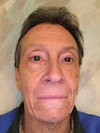 [In conversation recently with the French scholar Marie Auger, who interviewed me for her project on certain kinds of mixed-media photographic work from the 1970s, I learned, to my surprise, that a group show I reviewed in 1970 had in recent years become the locus of unusual attention.
[In conversation recently with the French scholar Marie Auger, who interviewed me for her project on certain kinds of mixed-media photographic work from the 1970s, I learned, to my surprise, that a group show I reviewed in 1970 had in recent years become the locus of unusual attention.
That show, “Photography into Sculpture,” the brainchild of Peter Bunnell, then Curator of the Museum of Modern Art’s Department of Photographs, opened on April 8, 1970 and ran through July 5. I reviewed it on April 12 in my column for the Sunday New York Times, offering a positive take on it, in contrast to a dismissive review by art critic Hilton Kramer that the Times published on April 9. For the next two years the show toured to eight venues in North America but, so far as I knew until a few weeks ago, it then sank into oblivion.
Hardly, it turns out. From Ms. Auger I learned that not only had this groundbreaking show received no fewer than four restagings over the past decade, but it had served as the primary subject of a book. The restagings brought together as many of the original works as possible, filling the gaps with comparable works by the same or other artists.
The book, of which I have only read brief excerpts, is The Photographic Object 1970, edited by Mary Statzer, University of Arizona and the University of California Press, with contributing essays by Eva Respini, Associate Curator, Department of Photography, The Museum of Modern Art. Statzer discusses my review in one chapter.
I have appended to this republication of my review a cluster of links to information about the original show, the restagings, the book, and some related writings. My thanks to Marie Auger for providing some of those links, and some of the recent materials.
As a sidebar, I should add that, as with all my articles for newspapers — the Village Voice, the New York Times, and later the New York Observer — I had no control over the headlines accompanying them. (This has to do with practical issues relating to deadlines, layouts, and such, and affects all contributors to daily or weekly print periodicals.) In my case, that chore fell to one Bernard Gladstone, a staffer on the Times “Arts & Leisure” section. Some, like this one, proved more apt than others. — A.D.C.]
•
Sheer Anarchy, or a Step Forward?
No microcosm better exemplifies Marshall McLuhan’s concept of the “global village” than the world of art in our time. Assimilationism is rampant in every creative medium, and experimentation so prevalent that the avant- and derriere-gardes seem to have reversed roles, with the more tradition-oriented now in a definite, if defiant, minority. The arts have so overlapped that it is fast becoming impossible to tell precisely to which media (save for the catch-all “mixed”) individual works belong without consulting wall labels, those esthetic equivalents of scorecards; and, with curators hot on the heels of each new breakthrough, even those are not always useful.
Boundary lines once thought to be inviolable — those between dance and theater, for instance, or between painting and photography — have been entirely eradicated in certain areas, and it is only a matter of time before other, theoretically clearer distinctions — between dance and painting, say, or music and film — become equally arbitrary. Indeed, future generations may not be able to distinguish between their sculptors and their painters (assuming, one hopes incorrectly, that they’ll share our own compulsion to pigeonhole) unless records are kept from birth indicating just which each artist touched first, finger paints or modeling clay.
Depending on one’s philosophical bent, this phenomenon can be viewed as 1) the penultimate stage of decadence, with nowhere left to go save — horrors! — sheer anarchy; 2) the necessary prelude to a puristic renaissance which will restore our guidelines, values, and morals; 3) merely the apex of another swing on the eternal Yin-Yang pendulum of polarities; or 4) the first step towards a desperately needed redefinition of art/creativity — namely, the elimination of inter-media competition and bigotry.
Leaning as I do in the direction of the third and fourth attitudes, I am generally undisturbed by the reverse fence-mending now current in the arts (though I sympathize enough with those who believe in the first two alternatives to share some of their angst and/or optimism). After all, if a sanitation engineer is happier engineering my sanitation than he was when, as a garbageman, he collected my garbage, who am I to say him nay? In other words, labels are critically meaningful — as opposed to utilitarian — only when they are applied by the artists themselves, and the difference between a graphic artist such as Robert Rauschenberg, who incorporates photographic images in his work, and a photographer such as Scott Hyde, who employs silk-screen techniques in producing his final picture, is one that I do not care to define.
Admittedly, this leaves me open to charges of begging the issue — but is there really an issue? Unless we are to assume that a work of art must, by definition, be something belonging to one medium and one only, and unless we are ready to certify that any combination — from painted Greek sculptures through Picasso’s collages to Lyn Wells’ “photosensitized contourmolded cloth sculptures” — is a bastardized creation whose illegitimacy precludes ascension to the throne of Art, there isn’t. We can only fall back on a pragmatic approach: Does it work? Does it affect us in some way, intellectual or emotional (or both), profoundly? Does it state its own terms and meet them? And, further, if a number of otherwise unrelated artists can be shown to be experimenting in the same vein, does this body of work seem to be exploring a fruitful creative territory?
Though I would answer all those questions affirmatively in dealing with most of the fifty works assembled by Peter Bunnell in the Museum of Modern Art’s new exhibit, “Photography into Sculpture,” the show is certain to arouse controversy, and not just in photographic circles. For one thing, instead of constructing a pigeonhole it deliberately tears one down; and for another, it offers the public a chance to reassume the burden of making its own evaluations.
“Photography into Sculpture” brings together the work of twenty-four American and Canadian artists (some of whom call themselves photographers, others painters or sculptors) whose work has two things in common: three-dimensionality and the photographic process. Their involvement in the potential complexities of photography range from minimal (Theodosius Victoria’s “View,” a camera obscura device created with a desk magnifier and a sheet of translucent Plexiglas) to maximal (Joe Pirone’s marvelously-titled “Succubus III: She Comes and Goes Bump in the Night,” a multi-layered series of images on transparent film, mounted in a box so that all are seen at once). Sculpturally, they run the gamut from Charles Roitz’s “Triptych” — a Metzker-like central panel composed of many images in a time-sequence, flanked by two apposite end panels — to the Lyn Wells piece mentioned previously, a life-size figure of sensitized linen stuffed with urethane, on which the front and back portraits of a man have been printed.
Is this Photography? I happen to think so — but if it isn’t, does it matter? If Dale Quarterman can create, out of styrofoam and photographic prints, an extraordinary object which serves as an illuminating visual metaphor for subtle relationships between the clothed and nude human form and the mental states of extroversion and introversion, must we be able to categorize it before we can appreciate it? (In fact, might not the very absence of easy categories force us to come to terms with “Marvella” — as this piece is called — rather than allowing us to file it away?)
Conversely, if Jerry McMillan’s “Door No. 2” — an acrylic painting in which certain portions, such as the floor, are scale photographs of those parts of the scene — amuses us only mildly with its trompe-l’oeil effect, can’t we write it off as one of his less significant works without putting a generic tag on its toe?
Most of the pieces in this show defy description, except of the most pedantic, curatorial, materials-and-processes sort. The methods are startlingly diverse, and the results are almost always stimulating, since they all force the viewer to examine his preconceptions about the relationships between the various media involved. Beyond that, they begin to weed themselves out qualitatively; but even the least of them — “BLT” by Robert Watts, for example, patently derived from Oldenburg’s food sculptures — are of more than passing interest.
 And the best transcend technical punning and gimmickry; the work of Quarterman, Pirone, Carl Cheng, Jerry McMillan (his “Bag” series is remarkable), Jack Dale, Ellen Brooks, Leslie Schneider, and Robert Heinecken — a founding father of sorts for this new school — is as demanding and rewarding as that being produced by their contemporaries in other branches of photography, and in other media as well. This, really, is the only criterion by which we can assess such investigations into new artistic territories. That such a direction as this may eventually prove to be a dead end is the risk taken by any artist who dares to explore one. As “Photography into Sculpture” demonstrates, however, there is much to be learned along the way by those who join the expedition; and at least some of the samples such pioneers bring back will prove to be more than mere souvenirs.
And the best transcend technical punning and gimmickry; the work of Quarterman, Pirone, Carl Cheng, Jerry McMillan (his “Bag” series is remarkable), Jack Dale, Ellen Brooks, Leslie Schneider, and Robert Heinecken — a founding father of sorts for this new school — is as demanding and rewarding as that being produced by their contemporaries in other branches of photography, and in other media as well. This, really, is the only criterion by which we can assess such investigations into new artistic territories. That such a direction as this may eventually prove to be a dead end is the risk taken by any artist who dares to explore one. As “Photography into Sculpture” demonstrates, however, there is much to be learned along the way by those who join the expedition; and at least some of the samples such pioneers bring back will prove to be more than mere souvenirs.
•
[First published in the New York Times, April 12, 1970, p. D30. Reprinted in Coleman, A. D., Light Readings: A Photography Critic’s Writings, 1968-1978 (New York: Oxford University Press, 1979), pp. 28-31.]
•
Restagings, in chronological order:
- “Photography into Sculpture / The Evolving Photographic Object in the US and Canada 1964-1970,” September 10 – October 22, 2011, Cherry and Martin Gallery, Los Angeles, CA. Organized by Mary Leigh Cherry and Philip Martin.
- “The Evolving Photographic Object in the US and Canada 1964-1970,” November 15-18, 2012, Cherry and Martin Gallery at Paris Photo, France. Organized by Mary Leigh Cherry and Philip Martin. (Note: The restaging by the Cherry and Martin Gallery won the International Art Critics Association award for Best Show in a Commercial Gallery Nationally in 2013. This gallery has since become the Martin Gallery.)
- “The Photographic Object 1970,” July 4 – September 29, 2013, Le Consortium Museum, Dijon, France. Curated by François Gautherot.
- “The Photographic Object, 1970,” June 26 – July 25, 2014, Galerie Hauser & Wirth, New York. “Conceived and organized with Olivier Renaud-Clément.”
From the Museum of Modern Art archives:
- MoMA online documentation of the original show: Installation views, wall label, checklist, press release.
Essays about the exhibition:
- “Mary Statzer on Photography into Sculpture, New York, 1970.” A pre-publication (undated, circa spring 2014) extract from or synopsis of her then-forthcoming book, at the Aperture blog.
- Gloria Williams Sander, “Thoughts on the Critical Fortune of “Photography into Sculpture.” Exposure, Fall 2015, Vol. 48:2. Sander is a curator at the Norton Simon Museum of Art in Pasadena, CA, and the West Coast editor of exhibition reviews for caa.reviews, the online journal of the College Art Association. Click here for a free PDF download of this article. Sander’s response to my review of the exhbition appears below:
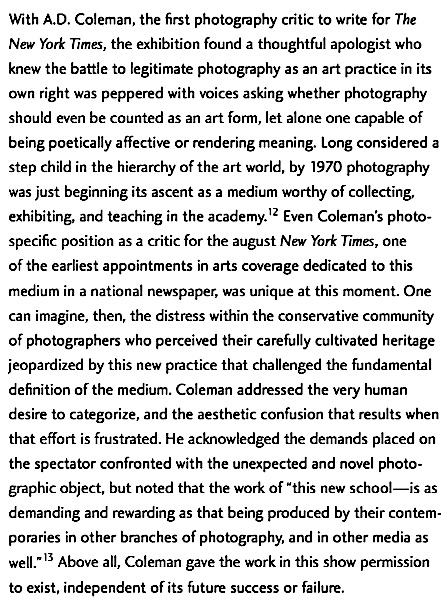
Gloria Williams Sander, “Thoughts on the Critical Fortune of ‘Photography into Sculpture'” (2015), excerpt
•
This post supported in part by a donation from Charles Mintz.
•
Special offer: If you want me to either continue pursuing a particular subject or give you a break and (for one post) write on a topic — my choice — other than the current main story, make a donation of $50 via the PayPal widget below, indicating your preference in a note accompanying your donation. I’ll credit you as that new post’s sponsor, and link to a website of your choosing.
 Include a note with your snail-mail address (or email it to me separately) and I’ll include three (3!) copies of The Silent Strength of Liu Xia, the catalog of the 2012-13 touring exhibition of photos by the dissident Chinese photographer, artist, and poet, who, after eight years of extralegal house arrest in Beijing, finally got released and expatriated to Germany in 2018. The only publication of her photographic work, it includes all 26 images in the exhibition, plus another 14 from the same series, along with essays by Guy Sorman, Andrew Nathan, and Cui Weiping, professor at the Beijing Film Academy. Keep one for yourself, share the others with friends.
Include a note with your snail-mail address (or email it to me separately) and I’ll include three (3!) copies of The Silent Strength of Liu Xia, the catalog of the 2012-13 touring exhibition of photos by the dissident Chinese photographer, artist, and poet, who, after eight years of extralegal house arrest in Beijing, finally got released and expatriated to Germany in 2018. The only publication of her photographic work, it includes all 26 images in the exhibition, plus another 14 from the same series, along with essays by Guy Sorman, Andrew Nathan, and Cui Weiping, professor at the Beijing Film Academy. Keep one for yourself, share the others with friends.

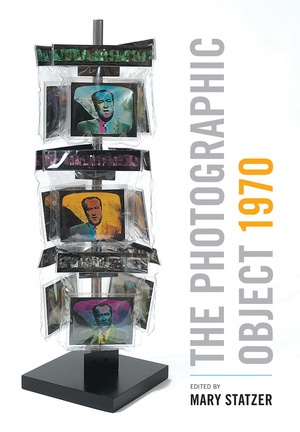
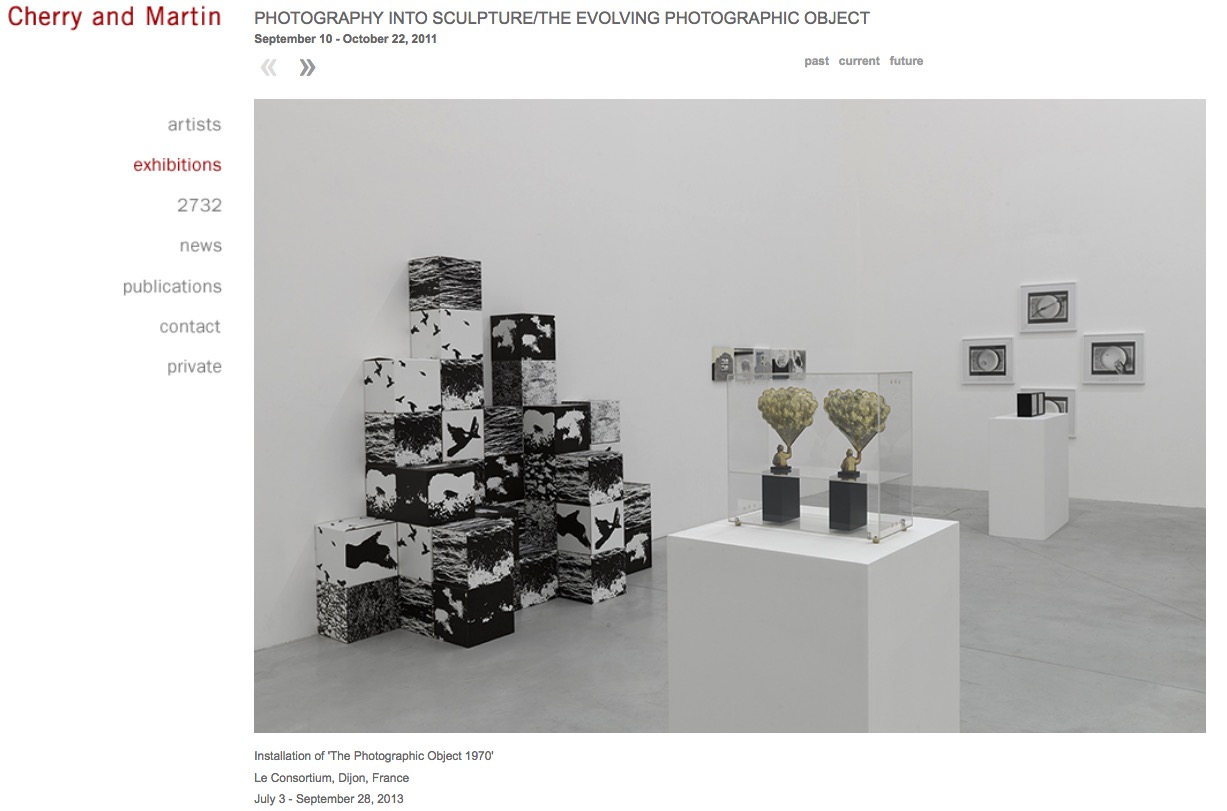
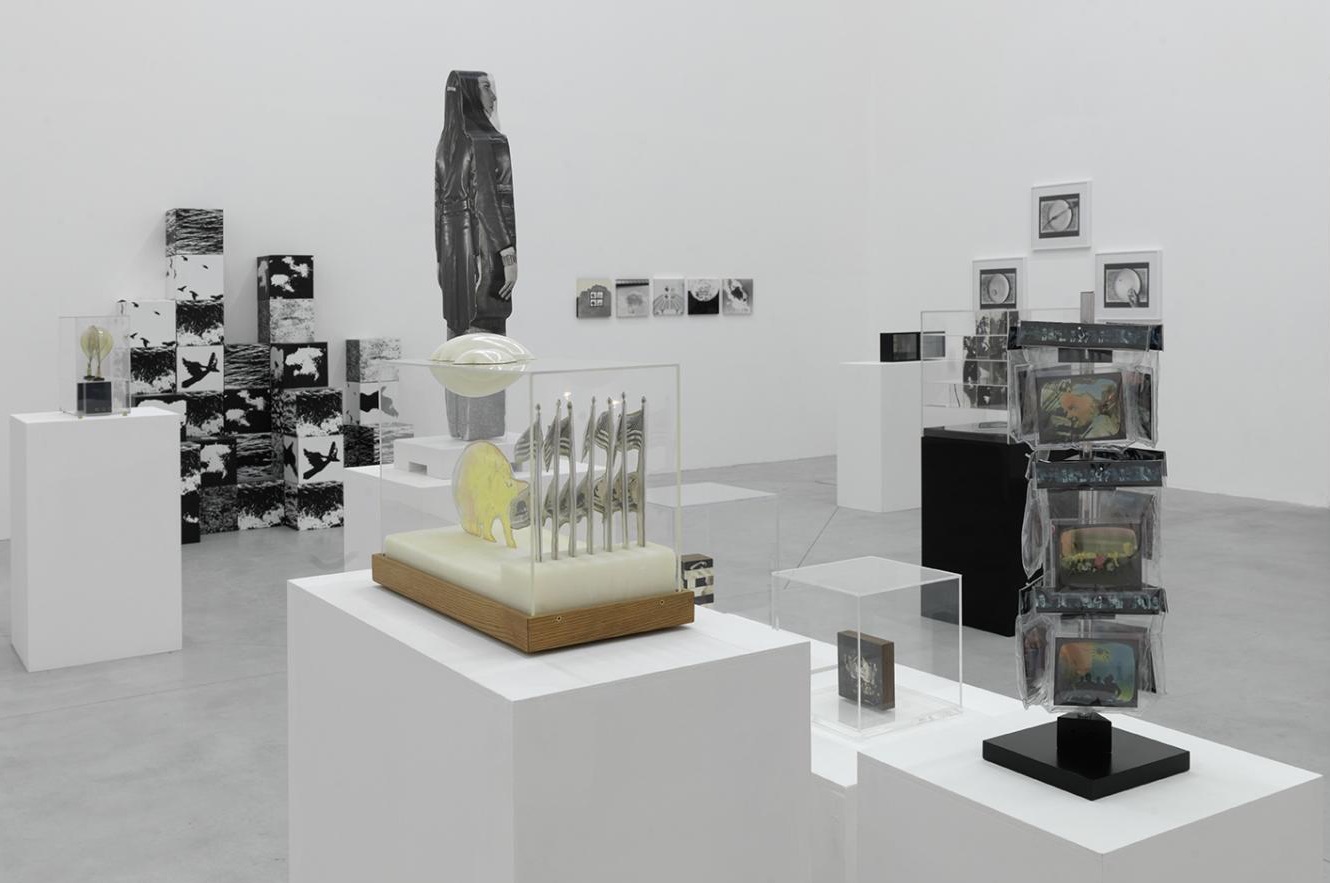
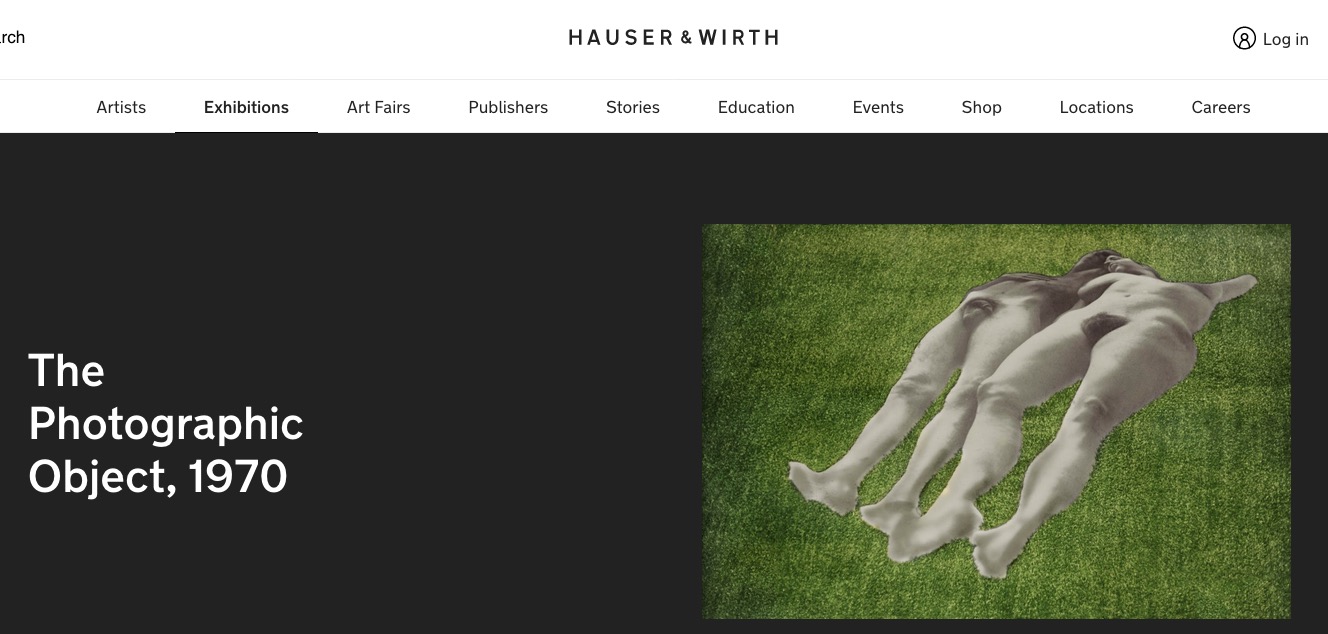




“Photography into Sculpture” did not fall into total oblivion.
Some histories of photography mention and sometimes even comment on it (Hirsch, Rouillé, Grundberg, Batchen, just from memory).
The fact that it has been only “reinvented” in the mid-2010s is probably due to this new conjuncture: a synergy at this precise moment between the market (four restagings by two commercial galleries) and the university (publications by the American scholar Mary Statzer).
Thanks for adding this footnote. Perhaps “oblivion” is too strong a word — “neglected” probably works better, since it sounds (from what you cite) as if the show was mostly mentioned in passing, and not subjected to any detailed analysis.